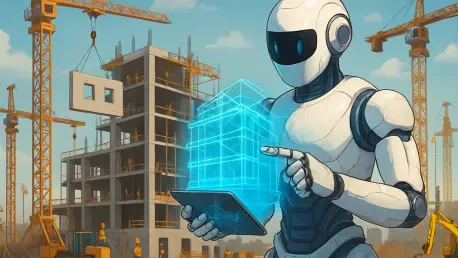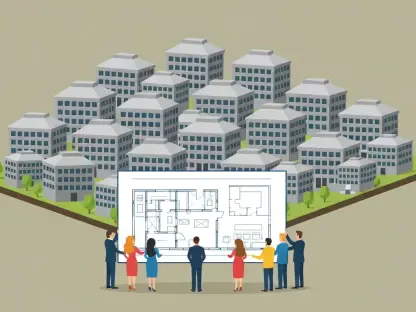The construction industry, a cornerstone of economic progress, stands at a pivotal moment as artificial intelligence (AI) emerges as a powerful catalyst for change, promising to address long-standing challenges. For decades, this sector has relied heavily on manual processes, human intuition, and field-based decision-making, often struggling with persistent issues like labor shortages, rising costs, and delayed timelines. AI, already a vital tool in numerous other fields, offers the potential to tackle these systemic problems with data-driven precision. Yet, the question remains whether an industry so deeply rooted in hands-on expertise can fully embrace such a transformative technology. Small and mid-sized contractors, in particular, face unique pressures with limited budgets and tight margins, making the adoption of new tools a high-stakes gamble. This exploration seeks to uncover if construction can harness AI’s capabilities to revolutionize core operations, or if historical resistance to innovation will hinder progress.
While the allure of futuristic tech often captivates attention, the real focus here lies in practical, immediate applications that can deliver tangible results on the job site. AI has the potential to reshape critical areas such as estimation, project selection, and job planning—domains where inefficiencies frequently lead to financial losses. By automating repetitive tasks and providing actionable insights, this technology could serve as a lifeline for contractors struggling to stay competitive. However, construction’s track record of slow tech adoption casts a shadow of doubt. Many in the field remain skeptical of tools that fail to directly enhance on-site outcomes, raising concerns about whether AI can prove its worth in a meaningful way. The balance between innovation and practicality will be key to determining if this technology becomes a cornerstone of modern construction or merely a passing trend.
AI’s Potential in Key Construction Areas
Estimation: Safeguarding Profits from Day One
Estimation stands as one of the most vulnerable stages in a construction project, where errors can erode profits before work even begins. AI offers a compelling solution by automating complex tasks like quantity takeoffs from digital plans or Building Information Modeling (BIM) files, drastically reducing the risk of human oversight. Beyond simple calculations, these tools can analyze historical job data to provide precise labor rates and productivity metrics, ensuring bids reflect real-world costs. Additionally, AI can flag potential scope gaps or design mismatches early in the process, helping contractors avoid costly change orders and delays. This technology doesn’t aim to sideline experienced estimators but rather equips them with sharper insights, allowing for more confident decision-making. By catching risks at the outset, AI could become an indispensable ally in protecting margins from the very first step of a project, addressing a pain point that has long plagued the industry.
The impact of AI on estimation extends beyond mere accuracy to fundamentally shift how contractors approach bidding. Traditional methods often rely on gut instinct or outdated spreadsheets, leaving room for miscalculations that snowball into financial strain. AI-driven platforms can integrate vast datasets, including past project outcomes and regional cost trends, to generate bids that are both competitive and realistic. This capability is especially crucial for small and mid-sized firms that may lack the resources for extensive in-house analysis. Moreover, by identifying potential red flags—such as material price volatility or incomplete specifications—AI helps mitigate surprises that could derail a job. The result is a more strategic bidding process, where decisions are grounded in data rather than guesswork. As these tools become more accessible, they could redefine estimation as a proactive, rather than reactive, component of construction management, setting a stronger foundation for success.
Project Selection: Picking the Right Jobs
Selecting the right projects and partners often determines whether a contractor thrives or struggles, and AI brings a data-driven edge to this high-stakes decision. By sifting through historical performance metrics, AI can evaluate past collaborations to identify general contractors who run efficient sites or developers with a track record of payment delays. This analysis culminates in a “fit score,” a tailored metric that assesses how well a potential project aligns with a firm’s strengths and capacity. Such insights empower contractors to focus on opportunities that match their expertise, rather than chasing volume at the expense of profitability. For smaller firms, where a single misstep can be catastrophic, this technology offers a way to minimize risk and prioritize jobs that bolster reputation and resources. AI’s role here is less about dictating choices and more about illuminating patterns that might otherwise go unnoticed.
Beyond identifying suitable projects, AI in project selection can reshape how contractors build long-term relationships in the industry. The ability to analyze subcontractor performance or client behavior over multiple jobs provides a clearer picture of who makes a reliable partner. This isn’t just about avoiding problematic engagements; it’s about fostering connections that lead to consistent success. For instance, AI might reveal that certain project types consistently yield higher margins for a specific contractor due to their crew’s specialized skills. Armed with this knowledge, firms can strategically target bids that play to their advantages while steering clear of mismatches that drain time and money. This shift from reactive to proactive decision-making could be transformative, especially for mid-sized contractors looking to scale without overextending. As AI tools refine their predictive capabilities, they could become a cornerstone of strategic growth, guiding firms toward sustainable opportunities.
Job Planning: Building a Strong Start
The critical phase between signing a contract and breaking ground often exposes vulnerabilities in project execution, but AI can help bridge this gap with precision. By transforming detailed estimates into actionable plans, AI aligns budgets with schedules and assigns crews based on availability and proven performance. This technology also excels at spotting potential disruptions early, such as long-lead items or supplier bottlenecks, allowing for timely adjustments. The result is a smoother transition to the field, where resources are allocated efficiently, and surprises are minimized. For contractors, particularly smaller ones with limited buffer for delays, this capability can mean the difference between a project that starts strong and one that stumbles out of the gate. AI’s ability to streamline this process ensures that execution matches contractual expectations, enhancing cash flow and margin control from the outset.
Another dimension of AI’s value in job planning lies in its capacity to create adaptive, dynamic schedules that evolve with project realities. Traditional planning often relies on static timelines that fail to account for on-the-ground changes, leading to cascading delays when issues arise. AI introduces the concept of a “living” schedule, one that updates in real time as new data—such as weather impacts or labor shortages—comes into play. This flexibility allows project managers to maintain control over complex jobs, reallocating resources or adjusting timelines without losing sight of overarching goals. Furthermore, by ensuring deliverables align with contract terms, AI helps safeguard against disputes that can strain client relationships. For firms operating on tight deadlines, this level of responsiveness is invaluable, turning a historically chaotic phase into a structured, manageable process. As these tools gain traction, they could redefine how readiness translates into results on the job site.
The Road Ahead for AI in Construction
Current Tools and Their Limitations
At present, many AI tools in construction operate within narrow confines, focusing on specific tasks like crew tracking or material forecasting without addressing broader challenges. While these point solutions offer incremental benefits—such as faster takeoffs or more accurate labor predictions—they often lack the integration needed to tackle the interconnected nature of project management. Contractors frequently find themselves juggling multiple standalone apps that don’t communicate, leading to fragmented workflows and missed opportunities for efficiency. This limitation is particularly burdensome for small and mid-sized firms that rely on streamlined operations to compete. Without a cohesive system, the full potential of AI remains untapped, leaving many in the industry questioning whether the investment justifies the return. Until these tools evolve to address holistic needs, their impact on transforming construction will remain constrained.
Another challenge with current AI offerings is their accessibility and relevance to the field’s unique demands. Many solutions are designed with larger firms in mind, featuring complex interfaces or high costs that alienate smaller contractors who form the industry’s backbone. Additionally, the lack of customization means these tools often fail to adapt to the specific workflows or regional nuances that define individual firms. For instance, a tool focused solely on urban high-rise projects may offer little value to a contractor specializing in rural infrastructure. This disconnect fuels skepticism, as many workers perceive AI as an impractical overlay rather than a practical asset. Bridging this gap will require developers to prioritize user-friendly designs and scalable pricing models that cater to diverse needs. Only then can AI move beyond niche applications to become a widely embraced solution across the construction landscape.
Future Vision: Integrated and Adaptive Systems
Looking forward, the true potential of AI in construction lies in the development of integrated platforms that unify disparate aspects of project management into a seamless ecosystem. Imagine a system that connects estimating, scheduling, procurement, and execution, allowing data to flow freely across every stage of a job. Such a platform would not only streamline communication but also enable real-time adjustments as conditions change, reducing the risk of costly missteps. For contractors, this means a single source of truth where insights from past projects inform current decisions, enhancing accuracy and foresight. The ability to learn from historical data—tailoring recommendations to a firm’s unique patterns—could transform AI from a mere tool into a strategic partner. As these systems mature, they promise to embed themselves into daily operations, driving efficiency without disrupting established processes.
Equally important is the adaptability of future AI systems to grow smarter with each project they support. Unlike static tools, these platforms could analyze outcomes over time, identifying trends such as recurring delays or cost overruns specific to a contractor’s work. This continuous learning process would enable the delivery of personalized coaching, offering actionable advice rather than generic outputs. For small and mid-sized firms, this level of customization is critical, as it ensures technology aligns with their limited resources and specific challenges. Integration with existing software will also be key, preventing the need for costly overhauls while maximizing usability. As developers focus on creating intuitive, interconnected solutions, AI could become a catalyst for digital transformation in construction, empowering firms to make decisions that are not just faster but fundamentally more informed. This vision, if realized, could mark a turning point for an industry long resistant to change.
Navigating the Path to Adoption
Reflecting on the journey so far, the integration of AI into construction reveals a landscape of cautious optimism tempered by practical hurdles. Initial skepticism gave way to gradual acceptance as early tools demonstrated value in isolated areas like estimation accuracy and crew scheduling. However, the fragmented nature of those solutions often left contractors wanting more comprehensive support, highlighting a gap between promise and delivery. Resistance rooted in the industry’s human-centric ethos persisted, with many workers viewing technology as a potential threat rather than an ally. Despite these challenges, incremental successes in automating mundane tasks and reducing errors laid a foundation for broader trust, setting the stage for what came next.
Moving forward, the emphasis must shift toward creating AI systems that prioritize integration and usability over novelty. Developers need to focus on platforms that connect disparate workflows, ensuring data-driven insights reach every corner of a project. Collaboration between tech innovators and industry veterans becomes essential to tailor solutions to real-world needs, especially for smaller firms with constrained budgets. Encouraging adoption through affordable, intuitive tools that complement rather than replace human expertise emerges as a critical step. By addressing deep-seated inefficiencies while respecting the hands-on nature of construction, AI has the chance to redefine operational standards. The path ahead demands a commitment to balancing technological advancement with the practical demands of the field, ensuring that transformation is both achievable and sustainable.









